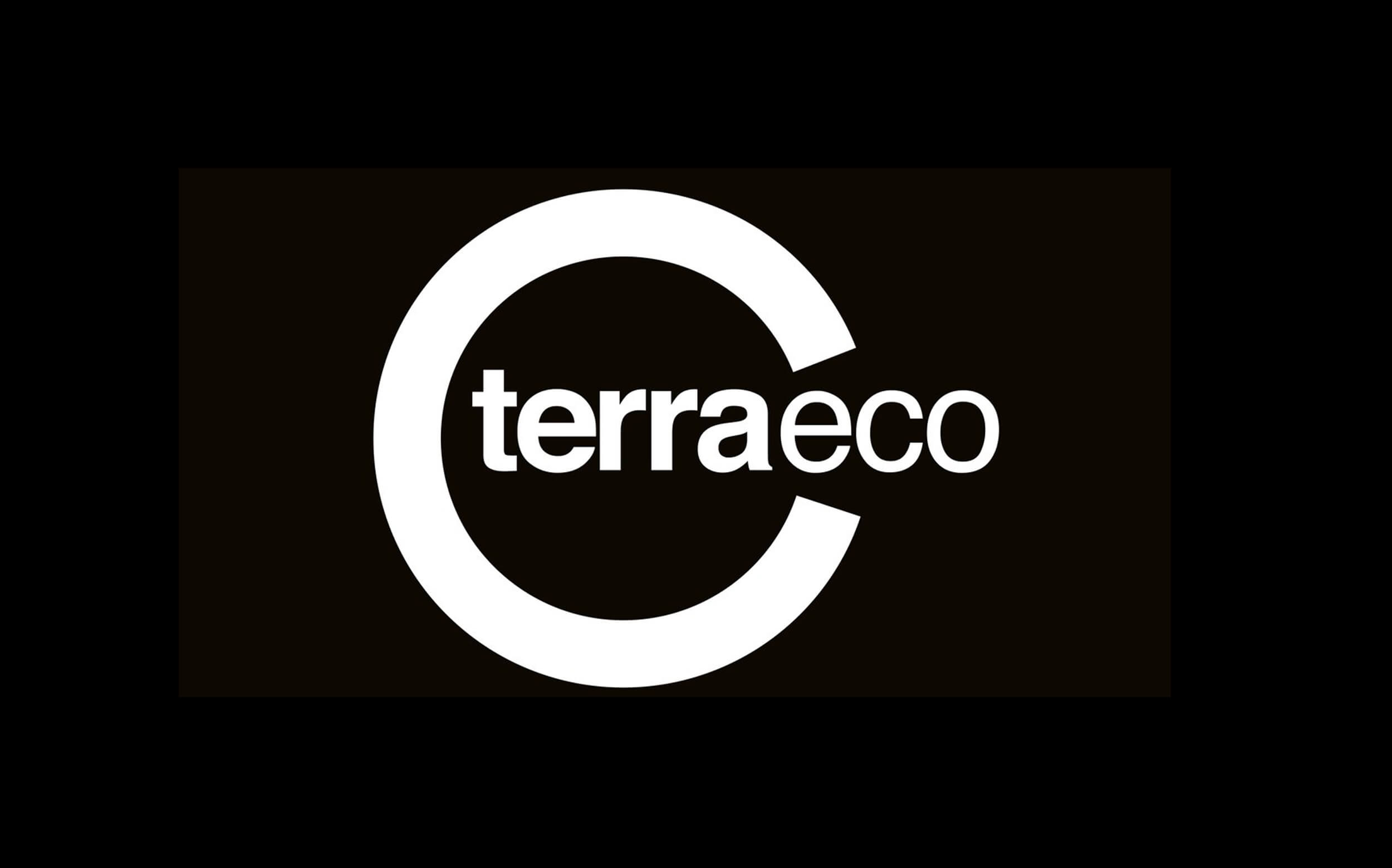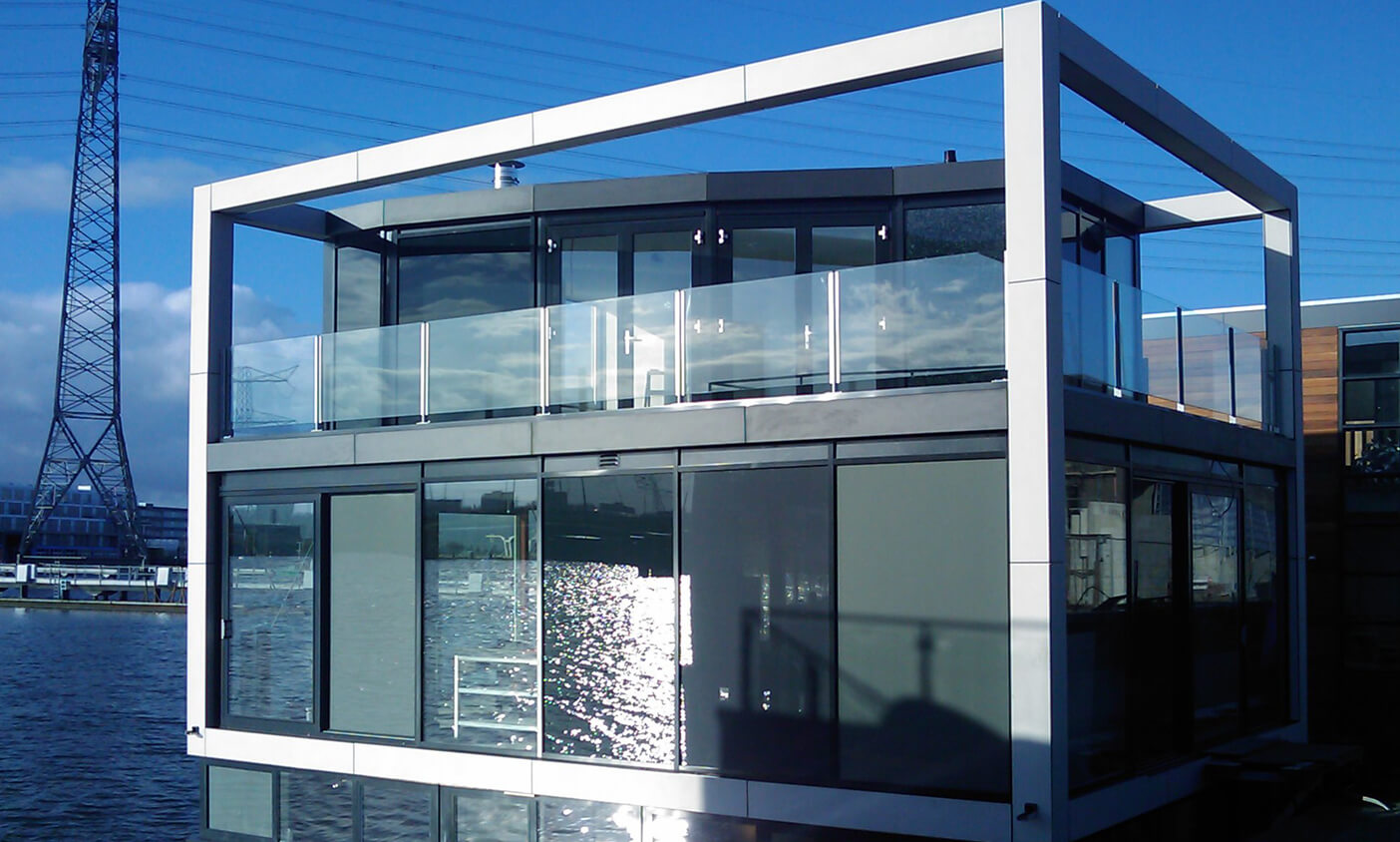AquaTecture, Buildings and cities designed to live and work with water
By Robert Barker & Richard Coutts
RIBA Publishing
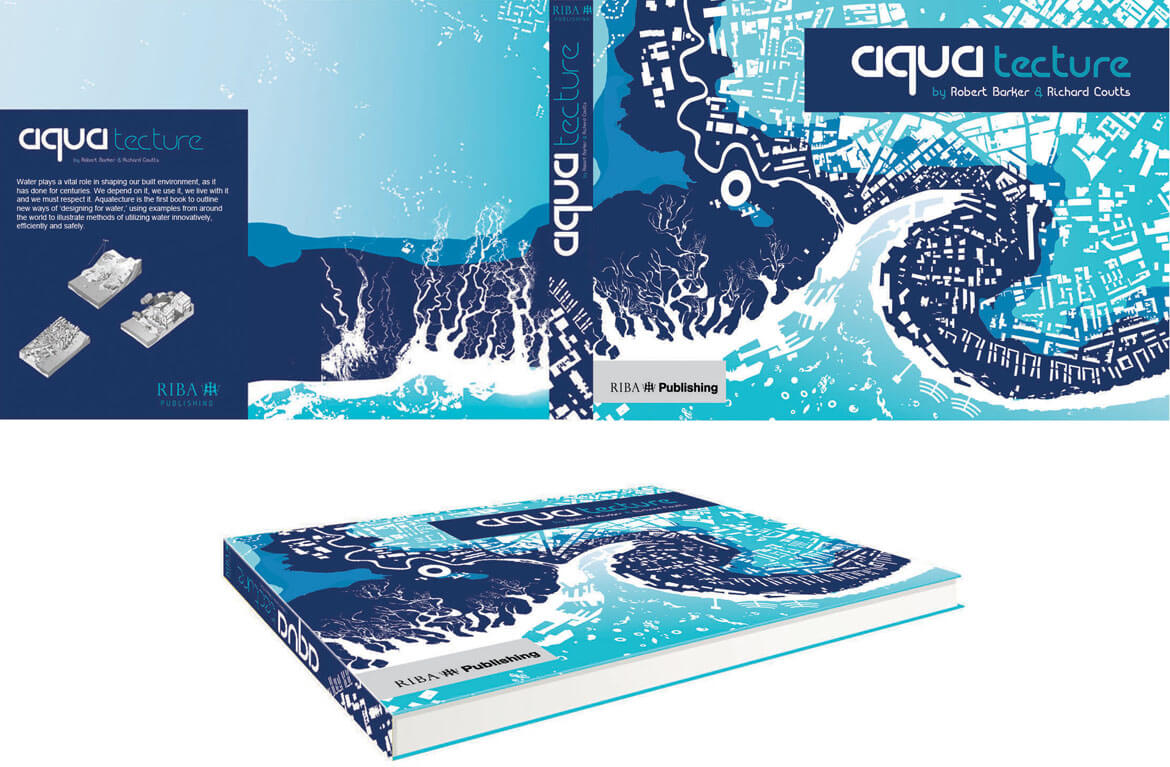
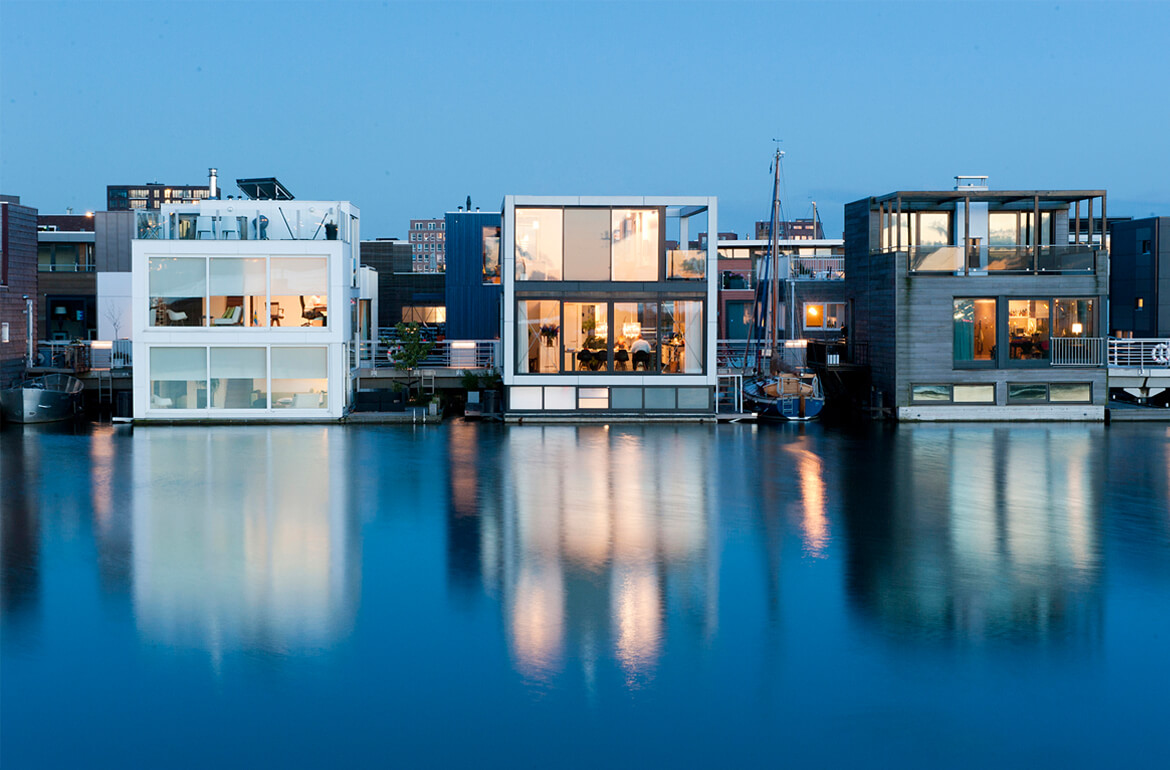
Water plays a vital role in shaping our built environment, as it has done for centuries. We depend on it, we use it, we live with it and we must respect it. Aquatecture is the first book to outline new ways of ‘designing for water,’ using examples from around the world to illustrate methods of utilizing water innovatively, efficiently and safely.
The first part of the book explores the historical relationship between water and architecture, examining how cities and civilisations have been drawn to water and have attempted to control it. The chapters go on to assess how this relationship has changed over time, and introduce readers to a range of brand new techniques that will revolutionise the way we think about water, design and urban planning. Solutions such as amphibious housing, wet-proof buildings, zero carbon development, rain gardens, flood storage and new methods of waterfront design are discussed and their effectiveness assessed.
Full colour illustrations and international case studies are used throughout the book to bring these new theories to life; practical, technical advice sits alongside truly ground-breaking and ambitious ideas for the future. This book is an ideal reference tool for all architects, urban designers, planners and sustainability experts who have an interest in creating a beautiful, sustainable, intelligent and pleasurable built environment on land, in water and with water.
The Floating Dutchman
By Kerstin Schweighöfer
FUTURE PERFECT
December 2015
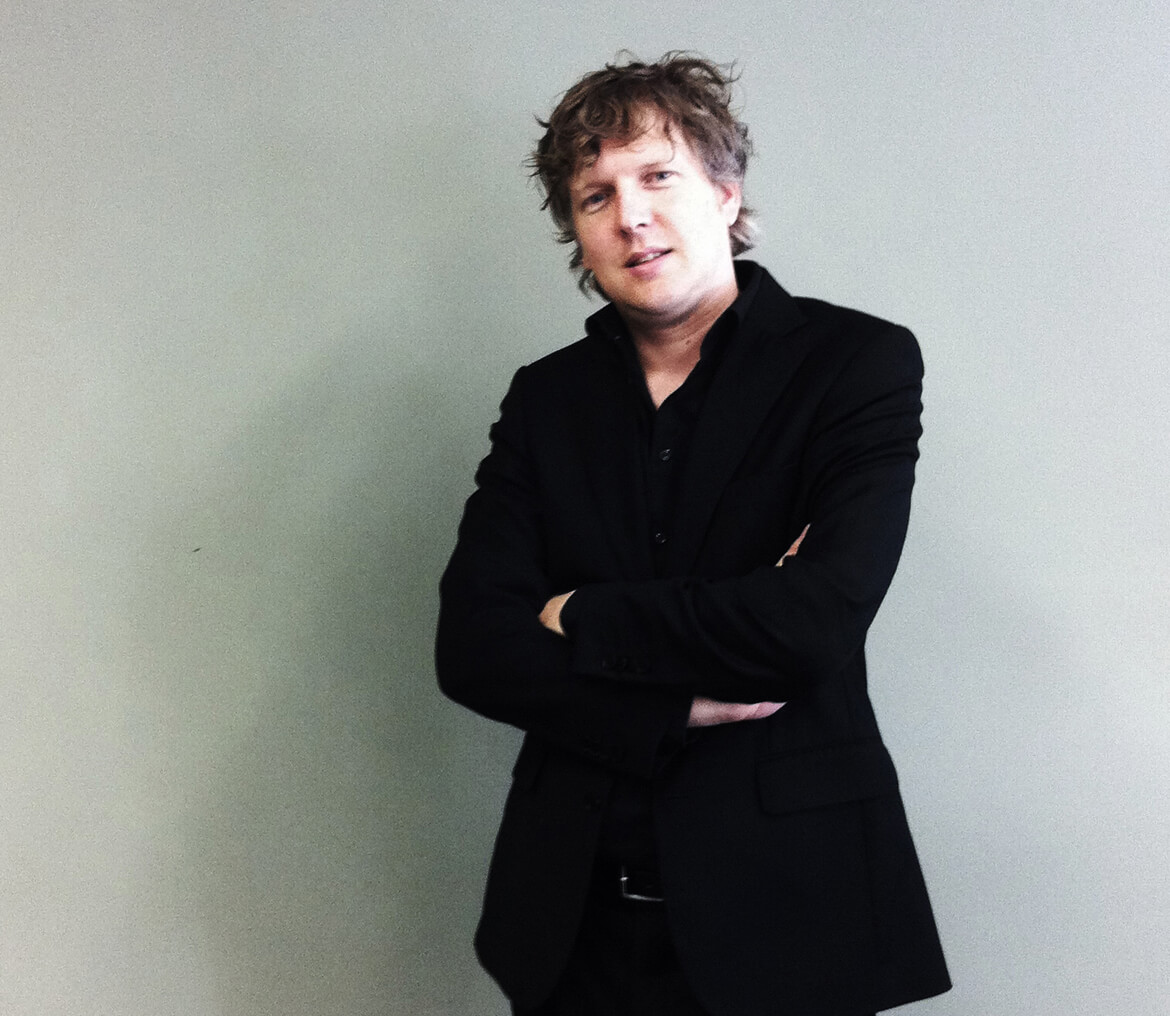
Koen Olthuis | © Architect Koen Olthuis, Waterstudio.NL

The Citadel is a floating apartment complex near Naaldwijk, Netherlands. | © Architect Koen Olthuis, Waterstudio.NL
THE FLOATING DUTCHMAN
In the tradition of his water-taming nation, Dutchman Koen Olthuis designs floating islands to dwell and live on – not least because climate change calls for new solutions in architecture.
A vacation doesn’t get more wonderful than this: a white sandy beach, a green-blue, glistening sea and an exotic underwater world to thrill any snorkeling enthusiast. All you have to do to explore it is jump into the Indian Ocean from your personal jetty, because the elegant vacation villa where you’re staying is floating on the water. In a Maldivian lagoon, this dream is currently becoming a reality as the construction of 185 floating vacation homes is currently underway. They’re arranged in the shape of a giant flower on the water. Hence the name of the project: Ocean Flower.
It was designed by Koen Olthuis, a Dutch architect who is considered a pioneer of what is called Aqua Architecture: “I build exclusively on the water,” says the 44-year-old with a strawberry-blonde mop of curly hair. His buildings are made to withstand floods and climate change because everything Olthuis designs can adapt to the level of the sea. It is not by accident that his office in Rijswijk near The Hague bears the name waterstudio.nl.
Bracing for climate change, without leaving a trace
In order to make such bold projects as the Ocean Flower a reality, Olthuis partnered with a fellow Dutchman, project developer Paul van de Camp, to found the company Dutch Docklands. It buys water properties all over the world to use them as building sites. This opens up completely new perspectives – not only for densely populated cities or countries where building sites are in short supply and hence, expensive: “It also helps residents protect themselves from the consequences of climate change.”
There is a reason Dutch Docklands launched its first project in the Maldives. It’s not just to cater to the recreational interests of spoiled tourists: The 300,000 inhabitants of the island nation will soon literally be up to their necks in water, because 80 percent of the Maldives are located barely a metre above sea level. The government had already announced plans to buy to land elsewhere in order to survive. Until Olthuis and van de Camp assured them that this was quite unnecessary: “We made the President of the Maldives understand that climate refugees can be pioneers of climate management,” said Olthuis. They understood immediately.
The Ocean Flower is just the beginning: Four more lagoons with floating vacation lodges are to follow, as well as a floating conference centre and one of the world’s most spectacular golf courses that will spread over several man-made islands to be connected by underwater glass tunnels.
And all this can be done without leaving a trace in nature or inflicting any damage, for Dutch Docklands is committed to what it calls the scarless approach: “Our units can float anywhere on the water for 200 years, yet if the area is needed for some other purpose, they can just be hauled away,” Olthuis explains. They will be gone without a trace.
The Dutch know how to live with the water
It isn’t surprising that the pioneers of Aqua Architecture are Dutch: Like no other people, the nation at the mouth of the Rhine River has spent centuries learning to tame the water or to keep it in check with dikes, dams and levees. As the proverb goes: “God created the world – and the Dutch the Netherlands.”
Whether it is in New Orleans or in Bangladesh: The expertise of Dutch hydraulic engineers and architects is in high demand throughout the world – today more so than ever, thanks to climate change, which brings swelling rivers, rising sea levels and more catastrophic floods around the globe.
The Dutch have long recognized that building ever higher dams won’t be enough. Therefore, the former nemesis is instead given more space: Polders are being flooded, retention basins are being built, tributaries being carved out and filled-up canals dug free again.
The old seafaring nation now has even less residential land available. Yet the Dutch discovered that the flooded polders and artificial water basins offer more benefits than just a controlled channeling of excess water.
Trend and challenge of generation climate change
As a consequence, aqua living has since become a trend in the Netherlands; all over the country, people reside in what is called waterwoningen. Their foundation consists of a concrete tub filled with Styrofoam, which is considered unsinkable. To keep them in place, they are moored to poles with rings so they can easily adapt to rising sea levels. Electricity and water lines are connected via hoses and cables.
Olthuis has designed countless waterwoningen: transparent villas sitting elegantly on the water, such as in Aalsmeer, Zwolle, Leiden or Amsterdam, which received an entire floating neighborhood in 2012, the steigereiland. In Antwerp, Olthuis designed a floating boulevard on the Scheldt, in Paris he created a restaurant on the Seine. And in a polder between The Hague and Delft, he wants to build de Citadel, Europe’s first floating apartment complex on a foundation of 140 by 90 metres. “Technologically speaking, all of this is easy to do,” he stresses.
The technology developed and patented by Olthuis virtually eliminates size limits on foundations for waterwoningen. In other words, the foundation can be a platform large enough to accommodate entire blocks of houses, complete with yards and parking garages: “The larger an object, the more stable it is on the water,” the architect explains.
Olthuis is therefore convinced: The city of the future consists of floating platforms that can be moved around like floes of ice. “It will evolve one step at a time,” the bold Dutchman predicts: The next fifteen years will see churches, schools and sports fields move out onto the water, then in 50 years, we will have platforms as large as 200 by 200 metres, with houses, roads and parks – until a century from now, the city of the future will be a reality: a flexible delta-metropolis of floating elements. For Olthuis, this new type of urban design, this new flexibility is “the great challenge for the architects of the climate change generation.”
Koen Olthuis at PChouse Award 2015 as jury & speaker
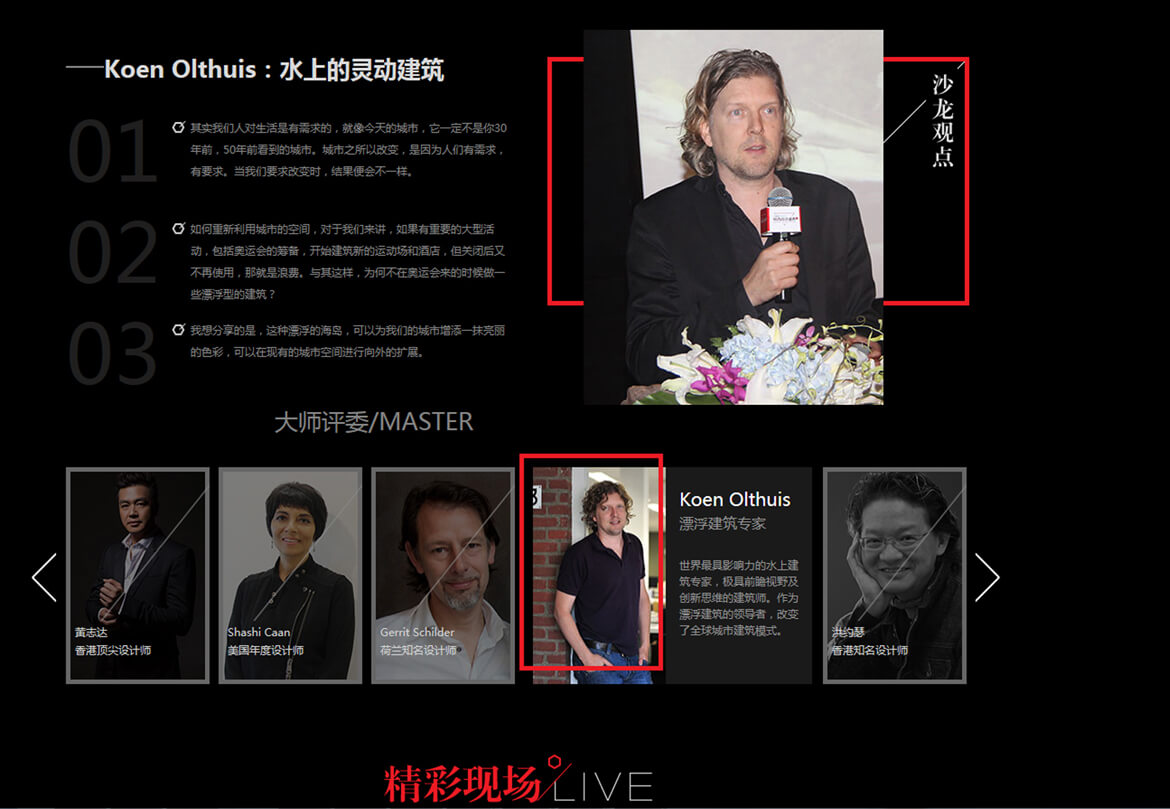
Koen Olthuis as one of the jury and speakers at the Modern Design Award for the top 10 best interior designs in Guanzhou, China 2015.
Why Blue is Better
Annelie Rozeboom
Hi Europe
October.2015
Architect Koen Olthuis draws on a roll of paper while explaining why we should be building our cities on the water and how he is planning to help the poor with his ideas. “As an architect, you can design towers, but every child can do that in their Minecraft game. Plus none of the towers we build now will be there in 300 years’ time. What I want to leave behind at the end of my career are concepts and ideas, the main idea is that we need to push our cities unto the water.”
Green is good, blue is better is the motto of this Dutch architect. “Our cities don’t change fast enough. We build houses and building and expect them to be used for ever, but our society changes every ten years. If parts of our cities float, we are much more flexible. The center of Amsterdam will always be the same, but the neighborhoods around it change all the time. If buildings float, you can just pull them away and put them somewhere else,” Olthuis told Hi-Europe.
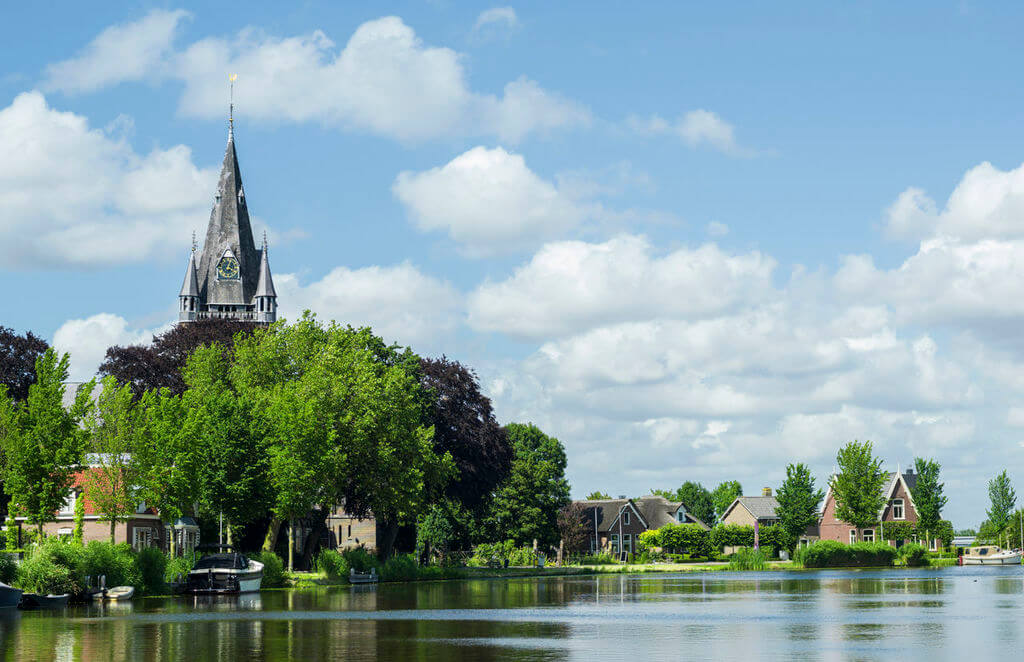
Pict: selimaksan
Working with the Water
One-half of the Netherlands is flood-prone and about one-quarter is below sea level, so it’s no wonder the Dutch spend their time developing ways to incorporate water into their style of living. The philosophy is shifting from fighting the water to living with it, or rather, on it. Instead of trying to claw back more land from the sea, developers are exploring the cost-efficiency of building homes that rise and fall with the tides. “We need to start working with the water in a more intelligent way,” Olthuis says.
This relatively new amphibious architecture is attracting interest from around the world, with floating and amphibious homes and schools now being designed for flood plains everywhere. Amphibious architecture is for both dry and wet conditions, so the houses stay dry and on the ground during normal times and then when the water arrives, they can float up.

Pict: Architect Koen Olthuis – Waterstudio.NL
Waterstudio
Olthuis wants to do much more than build a few villas. His architectural bureau Waterstudio.NL has designed complete apartment complexes, which could accommodate hundreds of people. And that is just one project. There is also a 33-meter-tall trees that can float. “Our cities have become sick environments. Green has been pushed away, but bees and other insects need quiet places. Our sea tree is like a cut-up park, which floats at a safe distance from the shore. Nature will take over on the platform and create its own ecosystem.”
Olthuis is also planning to help people in the slums of the world, which are often located on flood plains. “Worldwide you see that the most vulnerable people are being pushed into the water,” he says. This coming month he will send a floating school to Dakar – it’s a container that floats on empty plastic bottles. “The way to upgrade a slum is by installing facilities like schools and internet cafés, or easily movable small buildings that slum entrepreneurs can use. We have designed a kind of toolbox, which have 20 functions inside. This way, the entrepreneurs can choose what it is they need.”
Olthuis exports his concepts all around the globe, including to the flood zones of Hainan Island. “They have land there that they can’t use, but they will if they take our technology.” He also sells floating islands to Dubai. “Making artificial islands out of sand doesn’t work. In Dubai they built some, but they are too far away from the coast, and there is no electricity or drinking water. We are now going to put floating islands in between.”
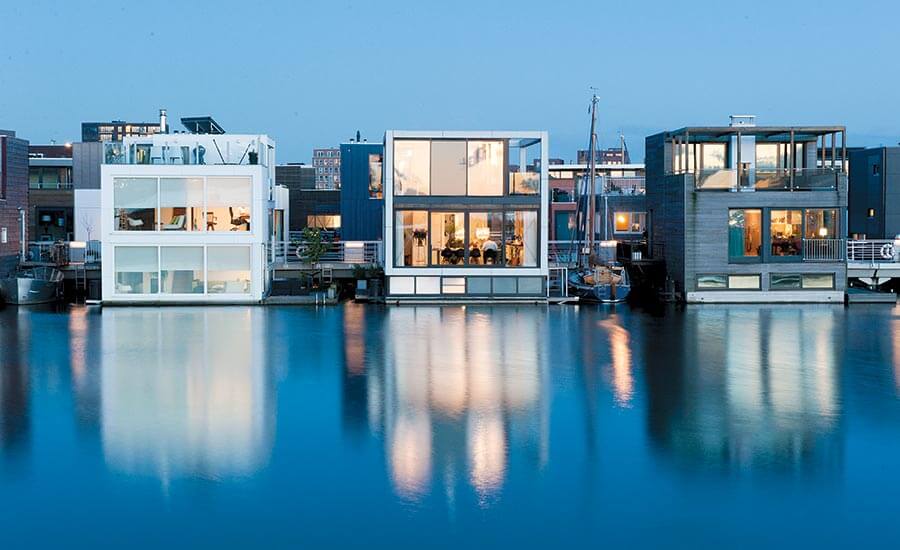
Pict: Architect Koen Olthuis – Waterstudio.NL
Fight Against the Sea
The Dutch are famous for their age-old fight against the sea, and they have the best flood management technologies in the world. In the beginning, the people in this low country put their homes on artificial hills called terpen, but they soon started building dikes. Popular in the middle ages were wierdijken, earth dikes with a protective layer of seaweed. Later dikes had a vertical screen of timbers backed by an earth bank, but these were replaced by stones after the timber was eaten by shipworms. When the polder windmill was invented in the 15th century, it meant that land could also be drained.
The dikes around the rivers were maintained by the famers who lived next to them. Special water board directors would come to check every three years. This changed radically after a devastating North Sea flood in 1953, which resulted in 1,800 deaths. The government adopted a “never again” attitude, and built dams all around the country, guarding all main river estuaries and sea inlets. According to computer simulations, today’s defenses in the Netherlands are supposed to withstand the kind of flood so severe that it would occur only once in 10,000 years.
“We have pretty much won the fight against the sea,” architect Olthuis says. “The problem now is rainwater. Holland has 3500 low-lying polders enclosed by dykes that function as sponges – they soak up excessive rain water. However, more and more of this land is now used for housing. These are ideal places to build amphibious houses.”
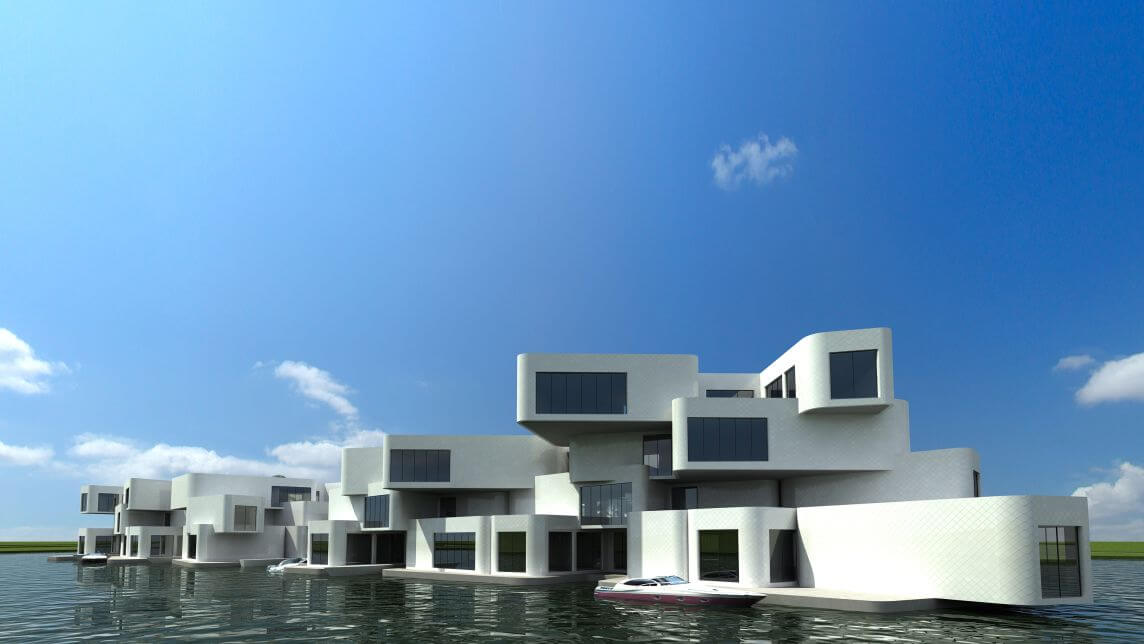
Pict: Architect Koen Olthuis – Waterstudio.NL
Rising Sea Levels
Dutch scientists predict a rise in sea levels of up to 110cm by the year 2100. “We can make the dikes higher, that’s not a problem at all. Technically, all that is possible. The problem with a high dike is that when it breaks, more water will come in,” he says.
There is also growing pressure on existing land. The Dutch government estimates that 500,000 new homes will be needed in the next two decades. Most of the land suitable for conventional building has already been used up, so Dutch architects are encouraged to experiment with new solutions. “The palace in the center of Amsterdam was built on 13.654 wooden poles. It’s the densest forest in the Netherlands. There was real innovation in those times. We are built on places where there shouldn’t be land at all. It’s not about giving up, it’s about continuing to grow,” says Olthuis.
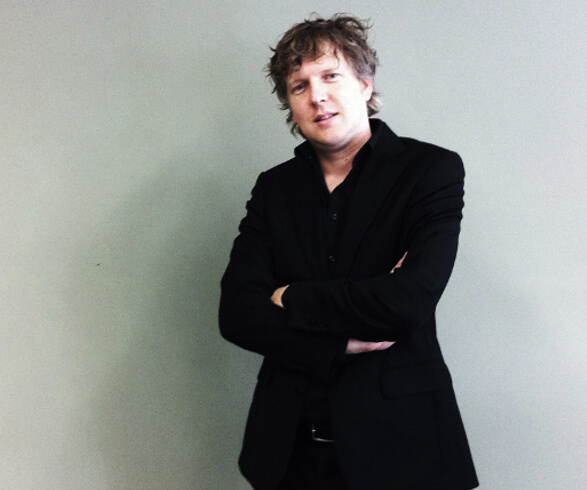
Koen Olthuis
Unique floating villa in Amsterdam for sale
This unique floating villa located in IJburg, Amsterdam is now for sale.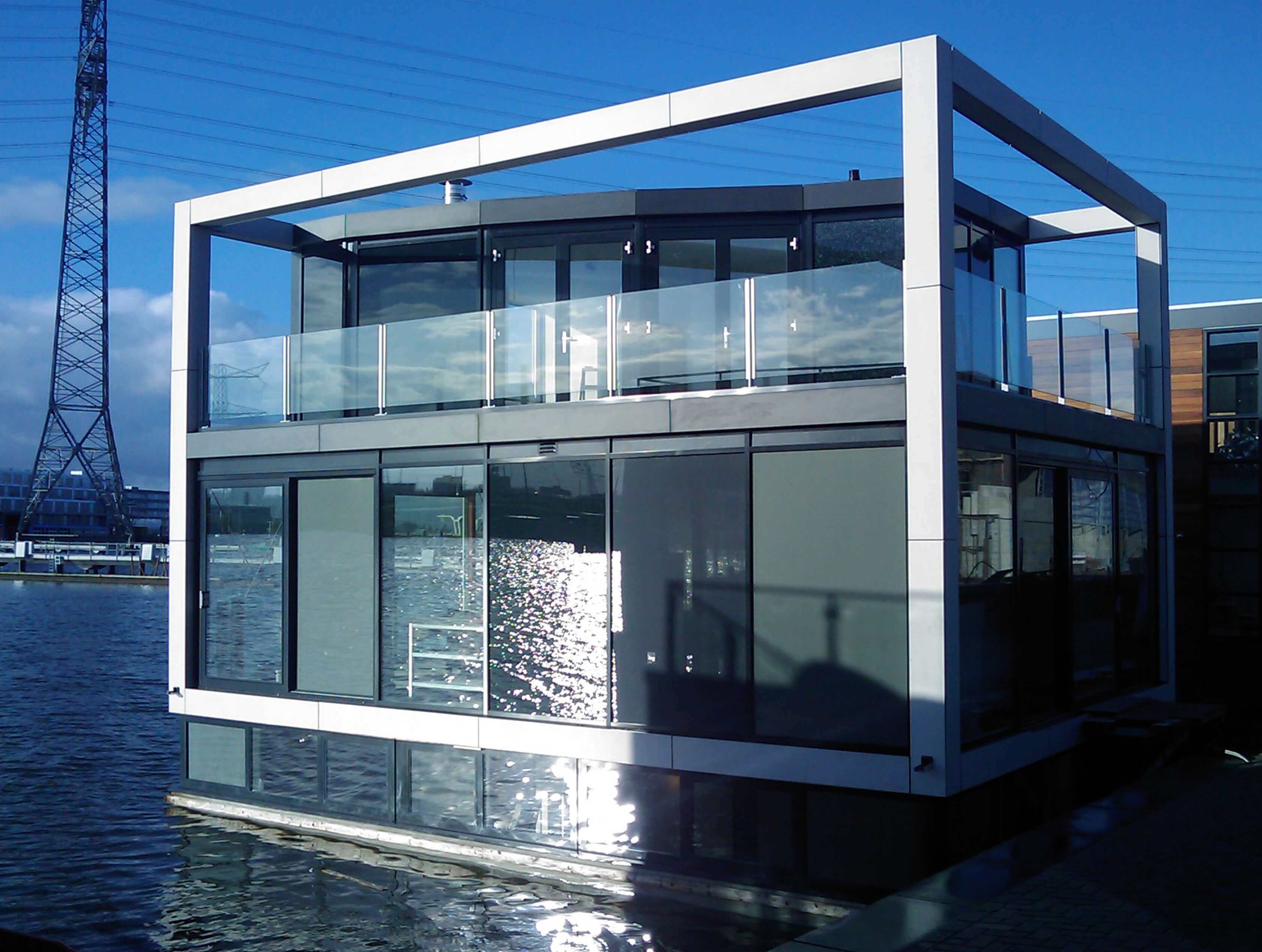
Vingt mille lieux sur les mers
By Frederic Joignot
Le Monde
Vinght mille lieux sur les mers: Comment les architectes voient la vie sur l’eau
Projet “Citadel” d’appartements, agence Waterstudio (Hollande). Il s’agit de construire dans des polders ouverts des habitations flottantes adaptées à la montée des eaux. C’est une “citadelle” parce qu’il s’agit “du dernier rempart contre la mer”, disent les architectes.
Un vieux rêve de l’humanité est de se réfugier sur une île pour y refaire sa vie, voire le monde, inventer une société meilleure, expérimenter des voies nouvelles pour l’humanité. C’est sur une île que Thomas More situait Utopia (1516), sa société idéale, au cœur d’une île encore que Tommaso Campanella imaginait la Cité du Soleil (1602) ou Sir Francis Bacon La Nouvelle Atlantide(1624), menée par les philosophes. Aujourd’hui, ces utopies insulaires sont rattrapées par la réalité terrestre : construire des cités écologiques sur des îles nouvelles est devenu un mouvement architectural. Né dans l’urgence de la menace environnementale, ce courant qui a gagné l’urbanisme interpelle, depuis dix ans, économistes, institutions internationales et gouvernements.
Ce mouvement a un drapeau – bleu, couleur des océans – et un pays pionnier : les Pays-Bas. Elu en 2007 parmi les personnes les plus influentes de l’année par le magazine Time, l’architecte Koen Olthuis, cofondateur de l’agence Waterstudio, à Ryswick, est l’un de ses praticiens et théoriciens. Il signe ses mails Green is good, blue is better (« le vert [le souci écologique], c’est bien, le bleu, c’est mieux ») et avance plusieurs arguments pour expliquer pourquoi construire sur les mers est une idée d’avenir : « D’ici 2050, 70 % de la population mondiale vivra dans des zones urbanisées. Or, les trois quarts des plus grandes villes sont situées en bord de mer, alors que le niveau des océans s’élève. Cette situation nous oblige à repenser radicalement la façon dont nous vivons avec l’eau. » Car, rappelle-t-il, les cités géantes du XXIe siècle sont mal en point : « La préoccupation “verte” qui saisit aujourd’hui architectes et urbanistes ne suffira pas à résoudre les graves problèmes environnementaux des villes. Comment allons-nous affronter les problèmes de surpopulation ? De pollution ? Résister à la montée des eaux ? » Sa réponse : en bâtissant des quartiers flottants, de nouvelles îles, en aménageant des plans d’eau pour un urbanisme amphibie. « La mer est notre nouvelle frontière », affirme l’architecte, détournant la formule de John Fitzgerald Kennedy. Car si l’espace manque sur terre, la mer est immense – et inhabitée.
Waterstudio n’est pas la seule agence néerlandaise à développer cette vision « bleue ». Plusieurs cabinets d’architecture et entreprises expertes, reconnues internationalement, bâtissent déjà sur l’eau. Il faut rappeler qu’aux Pays-Bas, contrée où l’on compte 3 500 polders et des villes sillonnées de canaux, s’adapter et résister aux assauts de la mer et aux inondations est une activité séculaire indispensable : en 1953, une violente tempête a causé près de 2 000 morts et provoqué l’évacuation de 100 000 personnes. Ce savoir-faire est devenu symbolique de la lutte de l’homme face à une nature menaçante, perturbée par le changement climatique. Désormais, « le monde est un polder », écrivait le biologiste Jared Diamond dans Effondrement. Comment les sociétés décident de leur disparition ou de leur survie (Gallimard, 2006).
Sauf que les polders, ces terres artificiellement gagnées sur l’eau, ne suffisent plus. Waterstudio a notamment conçu des maisons flottantes à IJburg, un quartier expérimental au sud-est d’Amsterdam. D’autres projets maritimes sont en cours. En 2009, l’agence a dessiné le projet Citadel, une cité flottante de 60 appartements installée dans un polder délibérément ouvert aux eaux. « Nous l’appelons Citadel, car ce sera la dernière ligne de défense contre la mer », explique Koen Olthuis, pour qui ce projet « montre clairement les possibilités infinies de la construction sur l’eau »
Au pays des polders, le fait de bâtir des immeubles flottants offre un complet renversement de perspective : « Nous cherchons à nous adapter à la mer, à l’accompagner, plutôt que lutter avec elle », explique l’architecte. Quand les habitations flottent, nul besoin de pomper l’eau, de renforcer en permanence les digues. Un nouvel urbanisme s’invente, où des quartiers entiers, jardins et maisons, reposent sur l’eau, parfois ancrés au sol, parfois mobiles. Une telle conception, avance l’architecte, va bouleverser toutes nos habitudes urbaines. Elle nous oblige à revoir « notre vision statique des villes » : la terre habitée ne sera plus tout entière « ferme ». Elle nous engage à repenser notre « exigence du sec » sur des territoires protégés par les digues, pour vivre sur l’eau. Elle annonce la multiplication d’habitats flottants et amphibies sur les zones côtières.
« Une ville plus mouvante, plus dynamique, se dessine. Certains habitats et services se déplaceront. L’urbanisme, la vie citadine vont en être transformés », conclut Koen Olthuis. Il n’est pas le seul à le penser. Du 26 au 29 août, signe des temps bleus à venir, se tiendra à Bangkok Icaade 2015, la première conférence internationale sur l’architecture amphibie. A Lagos, au Nigeria, l’architecte Kunlé Adeyemi a conçu une école flottante pour les enfants du bidonville de Makoko, sur la lagune. Posée sur des barils, équipée de panneaux solaires, elle a été inaugurée en février 2013. Kunlé Adeyemi prévoit de bâtir une flottille de maisons sur le même principe.
Les architectes de l’agence DeltaSync, à Delft, aux Pays-Bas, ont synthétisé ces idées dans un manifeste architectural et économique : « Blue Revolution ». Si les terres viennent à manquer, écrivent-ils, « où irons-nous ? Dans le désert ? Les ressources en eau manquent. Dans l’espace ? C’est toujours trop cher. Reste l’océan ». Notre planète de rechange est là. Car 71 % de la surface terrestre est maritime. Le texte continue : « Ce siècle verra l’émergence sur l’océan de nouvelles cités durables (…). Elles contribueront à offrir un haut standard de vie à la population, tout en protégeant les écosystèmes. Un rêve ? Non, la réponse au principal défi du XXIe siècle. »
L’agence DeltaSync, qui a construit en 2010 un pavillon flottant dans le port de Rotterdam, conseille le gouvernement néerlandais sur ses projets d’aménagement urbain, travaille sur la flottabilité et la stabilité de l’architecture aquatique. Elle développe avec l’université des sciences appliquées Inholland un projet de parc sur l’eau dans le port du Rhin, à Rotterdam : imaginez un petit archipel abritant un marché, une piscine, des restaurants, un centre de sport, une salle de concert. L’idée pourrait être reprise dans plusieurs villes néerlandaises, dans les ports ou sur des polders ouverts.
Un autre projet conçu pour un bassin portuaire est le Sea Tree, l’arbre de mer. Conçu par Waterstudio, encore dans les cartons, il révèle une autre dimension de l’architecture bleue : son exigence écologique. Il s’agit d’une haute structure en terrasses, entièrement végétalisée, construite selon les principes de la technologie offshore. Chaque grande ville côtière pourrait en installer. Ces arbres maritimes géants pourraient aider à lutter contre l’épuisement environnemental des grandes cités : ils comporteront des potagers verticaux et des terrasses plantées pour nourrir les citadins, ils capteront le CO2, ils abriteront quantité d’animaux utiles – oiseaux, abeilles, chauves-souris insectivores – qui rayonneront sur la côte et la ville proche. A Manhattan, à Singapour, les municipalités réfléchissent sérieusement à en installer, assure-t-on à Waterstudio.
On retrouve, dans ce projet de tour portuaire, plusieurs des idées-forces du courant dit de l’« architecture écologique », en plein essor. C’est un autre volet stratégique de la construction « bleue » : récupérer et consolider les principes de la construction « verte ». Autrement dit, s’appuyer sur les énergies durables (éolien, solaire, chauffage passif, géothermie), végétaliser les terrasses et les toits, intégrer les immeubles à l’écosystème local, s’inspirer des formes naturelles. L’architecte malaisien Ken Yeang, l’un des théoriciens de cette écoarchitecture, auteur de The Green Skyscraper (« Le gratte-ciel vert », non traduit, Prestel, 1999), a poussé cette réflexion très loin : selon lui, un immeuble doit être conçu dès l’origine comme un « système vivant construit », afin de pouvoir entrer « en symbiose » avec son environnement : sobre en énergie, recyclable, bioclimatique, l’habitat doit participer du cycle naturel, réintégrer la biosphère et dépolluer, tel un arbre colossal.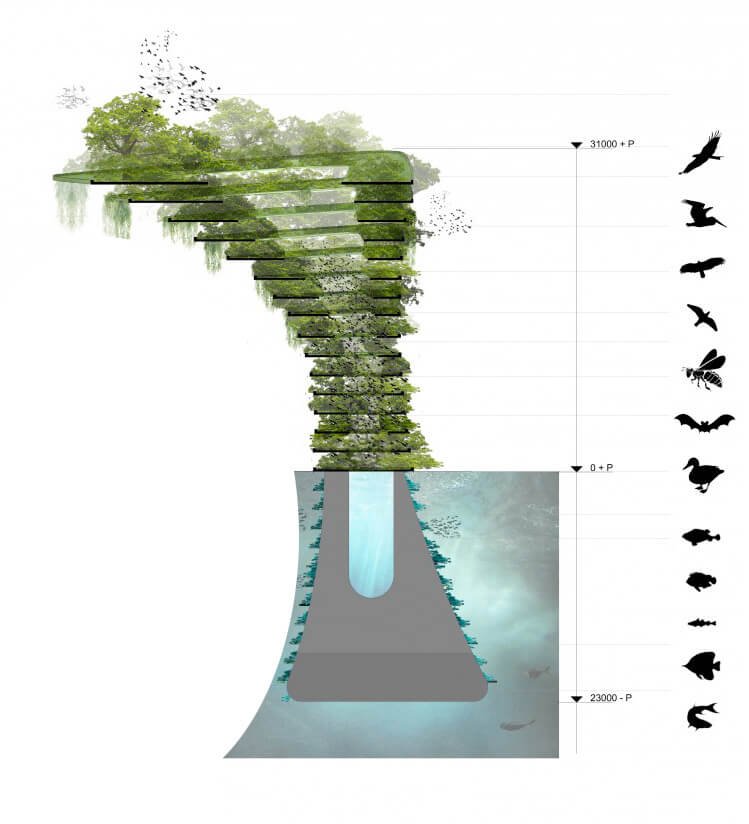
Pour bâtir cette cité aquatique, il faudra d’abord concevoir des grands caissons flottants de différents formats qui s’emboîteront jusqu’à former des îlots constructibles. Les premières unités doivent être mises en chantier cette année. Les commanditaires ont hâte de les tester : la pollution des grandes villes chinoises est telle que les autorités envisagent de construire rapidement à l’écart des zones atteintes. Sur l’eau, en face des cités enfumées. Demain, ces cités pourraient abriter une partie de la population littorale, désengorger les mégapoles, être économes en énergie, alléger la dégradation environnementale
Que répondent les architectes « bleus » à ces critiques et à ces risques d’une pollution aggravée ? Ils soulignent qu’ils ne veulent pas construire des îles artificielles, mais flottantes, qui n’altéreront pas les fonds marins. Et ils avancent un nouvel argument de poids : au XXIe siècle, l’humanité (9,6 milliards d’habitants attendus en 2050) va rencontrer de graves problèmes de terre arable, d’épuisement des stocks halieutiques et d’alimentation – toutes choses qui inquiètent beaucoup l’Organisation des Nations unies pour l’alimentation et l’agriculture (FAO). A Londres, pour les concepteurs de la Floating City, la cause est entendue : seule une future « colonisation » des mers permettra d’arrêter la conquête des terres par la ville. Ils écrivent : « La biologie terrestre a été soumise depuis longtemps à une exploitation si intensive que les terres encore inexploitées doivent être préservées de l’urbanisation. De nouvelles colonies maritimes devront être planifiées au XXIe siècle. »
C’est sur cette problématique de la disparition et de l’épuisement des sols, associée à une crise alimentaire, que les défenseurs de l’urbanisme marin rejoignent un autre volet de la « révolution bleue » : la croissance exponentielle de l’aquaculture mondiale depuis vingt ans. En 2008, selon un rapport de la FAO, l’aquaculture a fourni 46 % des poissons à l’échelle mondiale. Il s’agissait à 87 % de poissons d’eau douce, mais l’aquaculture marine est en progression constante, ainsi que l’algoculture et la conchyliculture (élevage des mollusques marins). Cela se comprend : la pèche industrielle menaçant d’épuiser les stocks de nombreux poissons, l’aquaculture apparaît comme une réponse viable pour nourrir les populations, même si elle rencontre de sérieux problèmes de gestion durable.
Or, les architectes bleus avancent que l’avenir de l’aquaculture maritime passera par l’édification de fermes et de bassins nourriciers à proximité des cités côtières. C’est l’idée qui est derrière un projet de l’agence DeltaSync, « Floating food cities will save the world » (« les villes alimentaires flottantes sauveront le monde »), développé par l’ingénieur Rutger de Graaf. Imaginant une nouvelle forme d’économie circulaire, il explique que la construction de récifs artificiels accueillant poissons et crustacés, de bassins d’aquaculture aquaponique recyclant les éléments nutritifs apportés par les déchets des villes flottantes, et d’îles agricoles permettra de nourrir les populations urbaines côtières. Selon lui, il suffirait que 1 % des mers soient consacrées à l’aquaculture pour nourrir l’humanité – le reste des eaux devant être sanctuarisé. Une étude de faisabilité accompagne ces projets
Les partisans de l’architecture « bleue » avancent enfin qu’elle devrait permettre d’éviter un des drames possibles du changement climatique : la submersion de nombreuses îles du fait de la montée des eaux. Le gouvernement des Maldives y croit, qui a lancé en 2010 un programme de constructions sur l’eau afin d’accueillir les populations menacées et de sauver le tourisme : des projets de villages amarrés mais aussi d’îlots de plaisance, d’hôtels et de golfs flottants sont à l’étude. Ces réalisations pionnières, encore très élitistes − « Les riches paient pour les prototypes qui serviront à tous », explique Koen Olthuis –, sont étudiées de près par les Etats insulaires d’Océanie, qui ont lancé en juillet 2014, lors du 45e Forum des îles du Pacifique, un appel de détresse aux pays industrialisés.
Ils ont rappelé que l’archipel de Kiribati, où vivent 110 000 personnes, risque de devenir inhabitable en 2030 – même si certains scientifiques assurent que les atolls vont s’élever avec les mers. Les autorités ont d’ores et déjà acquis 2 400 hectares dans les îles Fidji pour les reloger. Le président de la République des Kiribati, Anote Tong, a aussi évoqué la possibilité de construire une « île flottante » pour les futurs réfugiés climatiques. Or, deux projets de ce type existent dans les cartons des architectes bleus. Le premier, un ensemble de trois îlots végétalisés, agricoles, supportant une tour d’habitation géante, est étudié par le constructeur japonais Shimizu Corp.
Living Above and Below the Water
By Christopher F. Schuetze
The New York Times
April.23.2015
Living Above and Below the Water’s Surface in Amsterdam

Floating houses built on man-made islands make up the new neighborhood of IJburg in Amsterdam. Center, the home of Monique Spierenburg and Kees Harschel, whose seven-meter sailboat is docked right next to the living room. CreditFriso Spoelstra, Boat People of Amsterdam, Lemniscaat, 2013
AMSTERDAM — When asked about his three-story floating house in a gleaming new part of Amsterdam, Kees Harschel, a 65-year-old native Amsterdammer, likes to compare his living situation to winning the lottery.
“This house fits us like a second skin,” said Mr. Harschel, a retired physical education teacher, sitting in his dining room on the ground — or in this case water-level — floor of the house he has shared with his wife, Monique Spierenburg, since the couple had it built seven years ago.
In Mr. Harschel’s case, the comparison with a game of chance is more than just pride of ownership: To become part of the community of 36 houses floating on an artificial lake on Steigereiland, one of several man-made islands that make up the burgeoning new neighborhood of IJburg, Mr. Harschel competed with more than 400 applicants.
“My wife said: Go on, gamble — you won’t win anything, so try it,” said Mr. Harschel, who lived in a house on the Amstel river before moving to IJburg. But winning a spot in the small community — which the couple did in 2007 — was just the first step in a journey that would include hiring a renowned architect and battling the bureaucratic wrangling that comes with being a building pioneer in Europe.
The result is an expression both of one couple’s love of the water and of innovative living for which the Dutch — long known for their centuries-old ornate houses — are garnering an international reputation.
IJburg, home to about 20,000 people currently, is expected to eventually house 45,000. It has been rising over the past decade on a succession of artificial islands to the southeast of the city center, conceived to ease a chronic housing shortage. The area attracts many young families and professionals who, with a newly built tram line, can be in the heart of Amsterdam in 10 minutes.
The city has taken care to create a mixed community, with mansions, social housing and both market-rate and fixed-rent apartments, all sharing courtyards, public squares, parks, shopping centers and canals.
And while the 36 houses in Mr. Harschel and Ms. Spierenburg’s part of the neighborhood are all individually designed and built, those across the lake are by a single developer. Some are rented and some are owned by their inhabitants.
The couple’s house, which is nine meters, or 30 feet, high, rises just seven and a half meters above the water surface (the submerged 1.5 meters is part of the fully functional bottom floor) and is seven meters wide and 10 meters deep. (The width of the house is set by the size of the lock connecting the IJmeer to the little lake that would become its home.) Over all, the design accommodates 175 square meters of total floor space, or 1,880 square feet, with a 35-square-meter roof terrace.
The interior is the essence of Dutch simplicity. The main floor has a kitchen and dining room, where the couple do most of their socializing. Vast windows ensure the interior is flooded with diffuse reflected light and offer views of the IJmeer and the rest of the floating neighborhood.
The top floor is divided between an indoor living room and an outdoor patio. When the doors are open in the summer, the space becomes one, evoking architecture from much warmer climates.
Built to suit the couple, the basement includes two bedrooms, a master bathroom, an infrared sauna, a study and, according to Mr. Harschel, one of the most important rooms in the house: a two-and-a-half-square-meter woodworking and repair shop.
Although the house feels like a normal house, it is actually floating on its concrete basement foundation. (Power, water and other services are supplied via the fixed dock, which also acts as the land access, installed and maintained by the city.) Eye-level windows in the basement afford just-over-surface views.
Its unusual construction allowed the house to be built miles away from where it now floats, and if Amsterdam’s building code did not forbid it, the owners could simply take it with them when they moved.
“I’m a sailor,” said Mr. Harschel, who pilots saloon boats — canal boats often used for private day trips — around Amsterdam. His seven-meter Thalamus Working Boat is docked right next to the living room.
“On summer evenings we can just take some beer, wine and toast and have dinner out on the water,” said Mr. Harschel, who last summer sailed to the south of England, departing from and returning to the side of his house.
On the rare occasion when the lake freezes over, Ms. Spierenburg straps on her speed skates and takes to the ice without having to leave her house to reach the rink.
“It is much more a gateway to freedom than it is just a place to live,” said Koen Olthuis, who designed this house and whose architectural office, Waterstudio, specializes in designing floating buildings all over the world. “Skating around the house, swimming around your house — it’s marvelous.”
Both owner and architect concede that being one of the first houses on the pier came with costs.
“They paid a bit for the things we learned,” said Mr. Olthuis, explaining that the pioneering families did pay — in money, time and frustration — for what the city was learning about urban planning on water.
“It was a book this thick, but we were free,” joked Mr. Harschel, waving an imaginary building code volume.
Mr. Olthuis noted that the house had been built following code for land houses, which, in keeping with a mandate to build greener houses in the Netherlands, stipulated triple-glazed windows, heavy insulation and even a heat exchanger to retain heat from effluent — something that most houseboats, which tend to be light houses on a heavy foundation, avoid.
Mr. Harschel estimates that the couple spent 350,000 euros, or $380,000, to build the house (the lease for the lot is €600 a month), and guesses that the value of the property has probably more than doubled in the years since it was built.
“These people living here are pioneers; they are willing to take a risk, they are willing to try stuff out,” said Mr. Olthuis. “They all have a very strong feeling of freedom. That’s why they came here.”

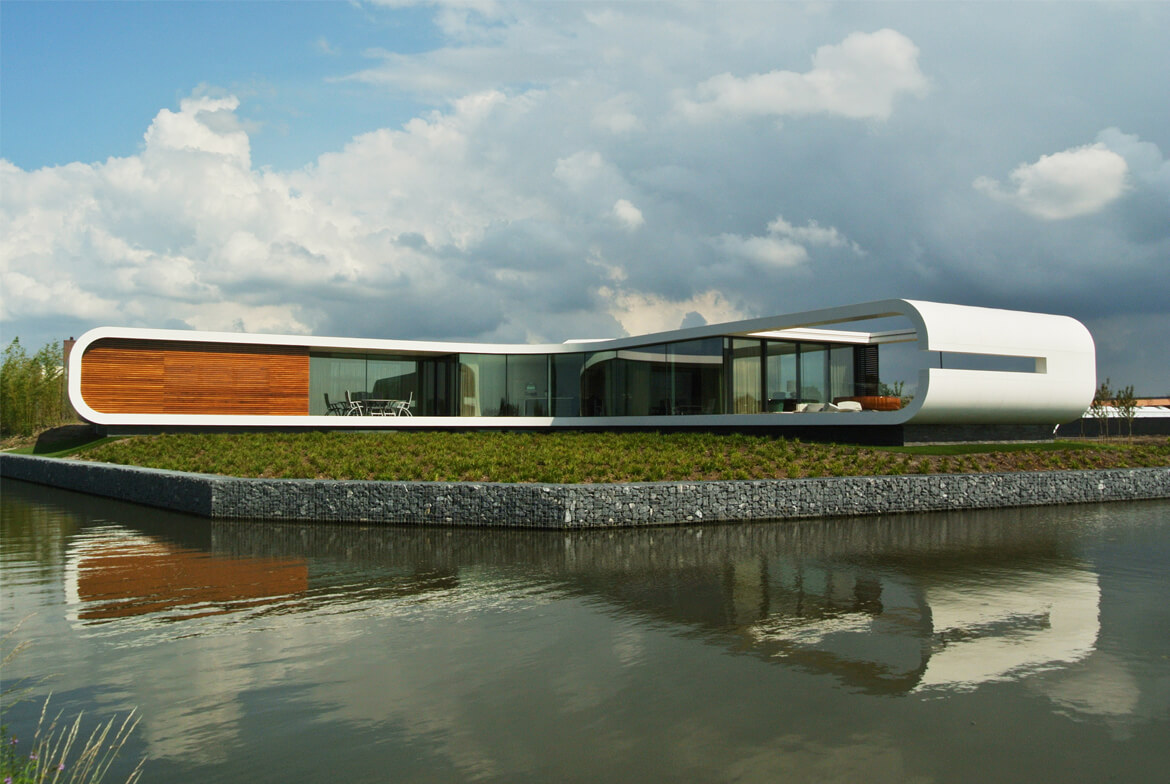
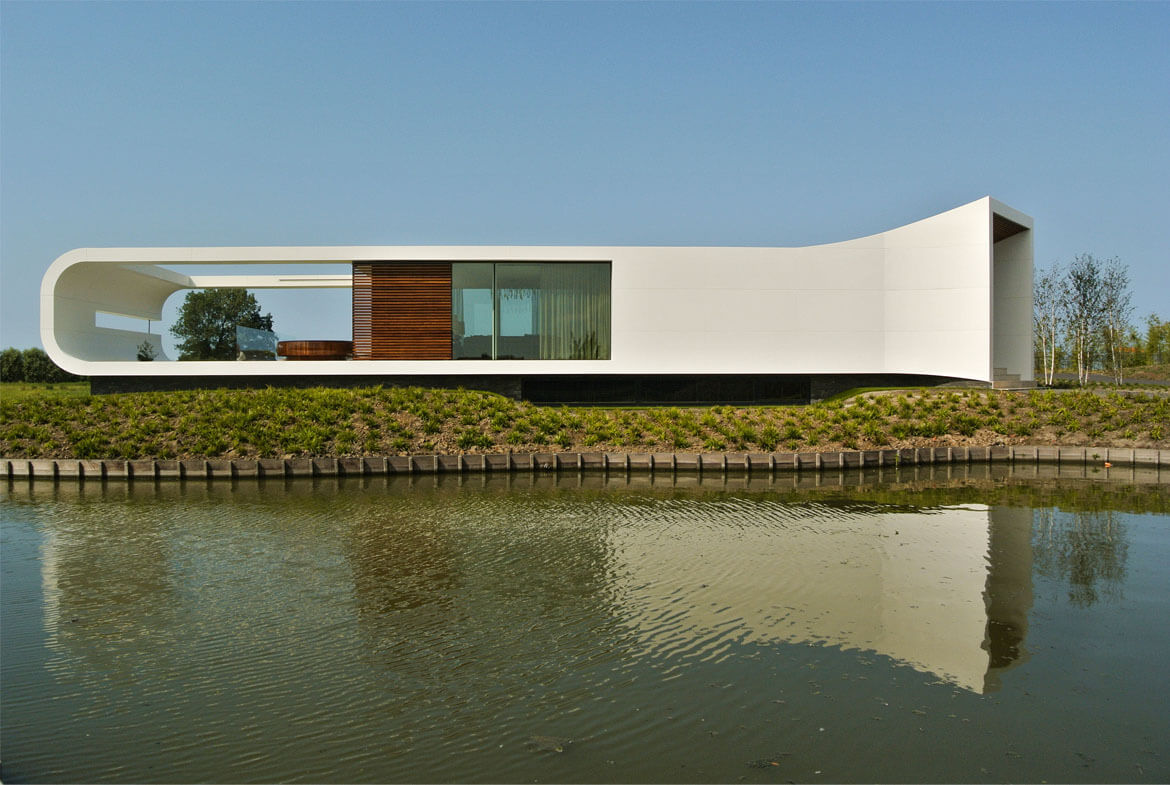
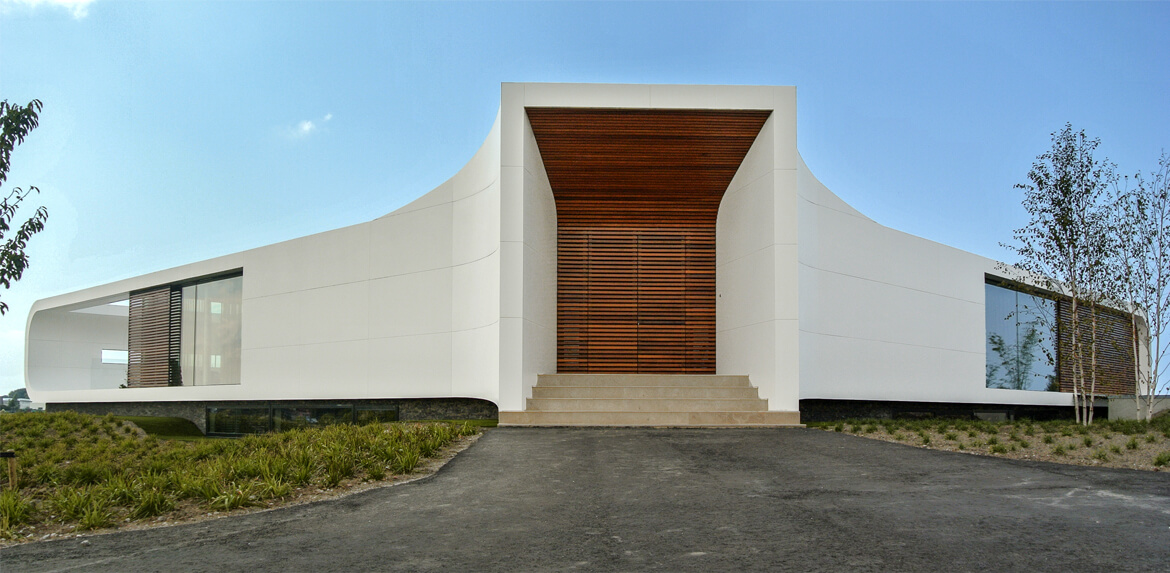
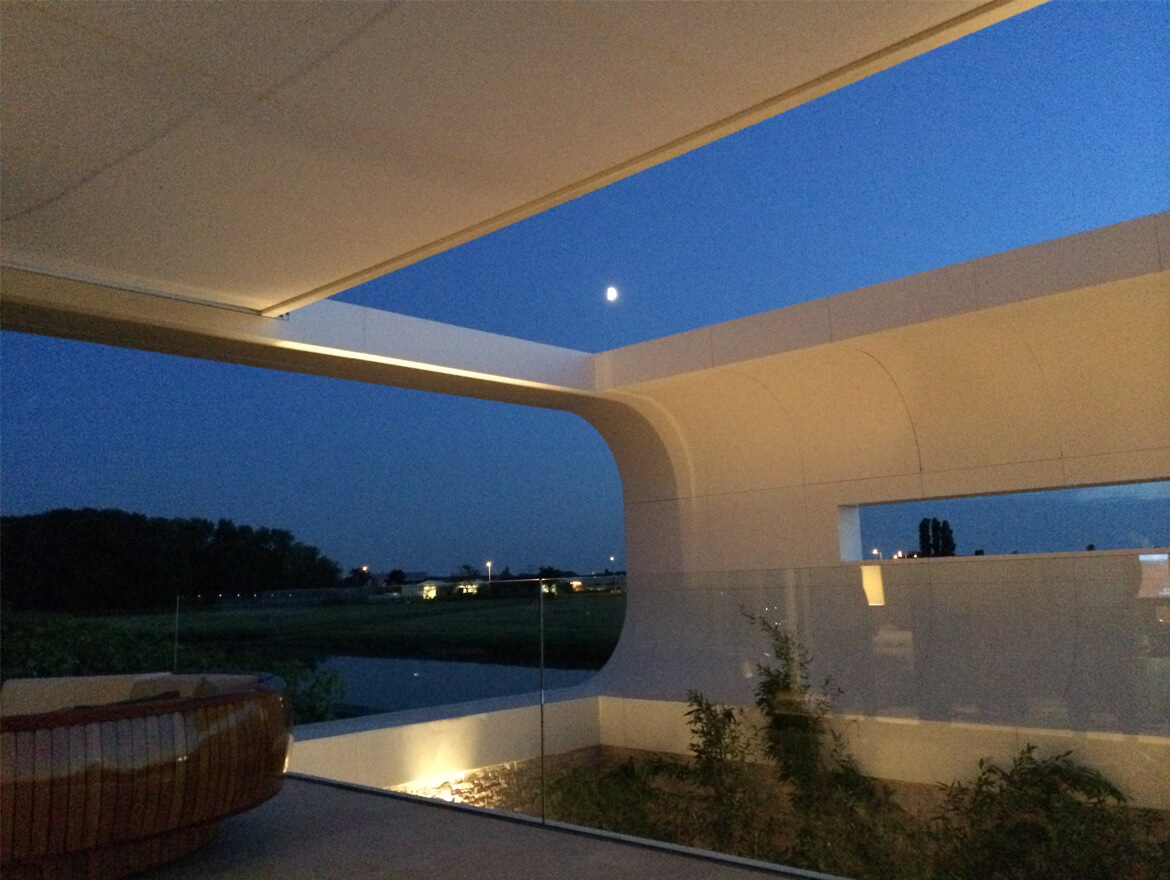
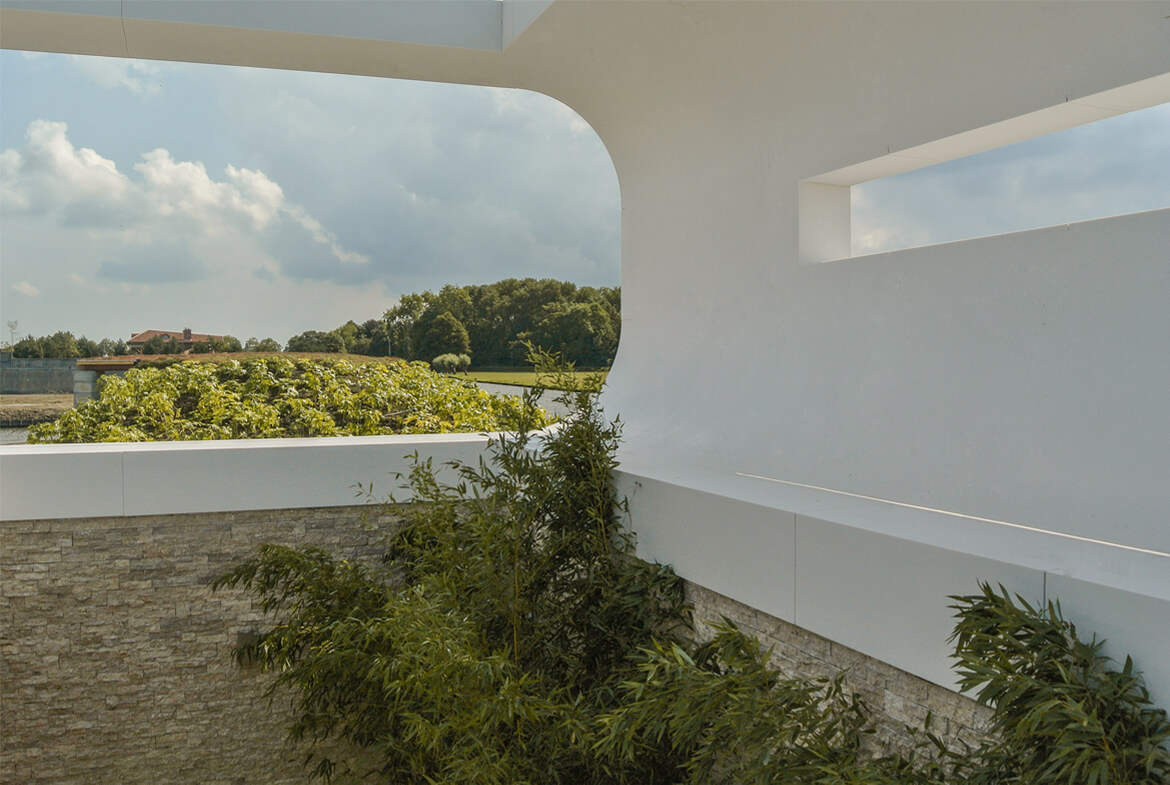
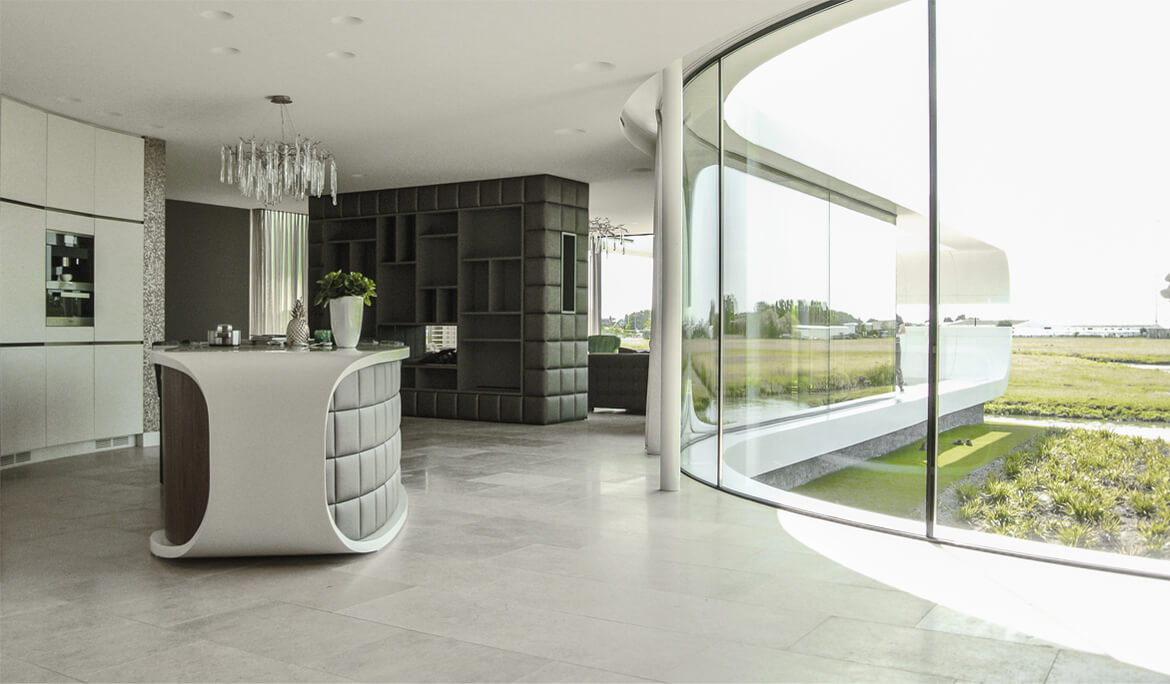
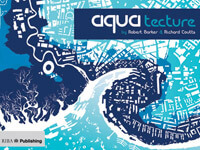
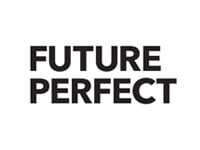


 Hi Europe
Hi Europe

